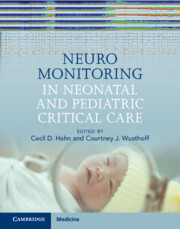Book contents
- Neuromonitoring in Neonatal and Pediatric Critical Care
- Reviews
- Neuromonitoring in Neonatal and Pediatric Critical Care
- Copyright page
- Contents
- Contributors
- Acknowledgements
- Part I General Considerations in Neuromonitoring
- Part II Practice of Neuromonitoring: Neonatal Intensive Care Unit
- Chapter 7 Neonatal Encephalopathy
- Chapter 8 Neonatal Seizures Due to Acute Causes
- Chapter 9 Neonatal Onset Epilepsy
- Part III Practice of Neuromonitoring: Pediatric Intensive Care Unit
- Part IV Practice of Neuromonitoring: Cardiac Intensive Care Unit
- Part V Cases
- Index
- References
Chapter 8 - Neonatal Seizures Due to Acute Causes
from Part II - Practice of Neuromonitoring: Neonatal Intensive Care Unit
Published online by Cambridge University Press: 08 September 2022
- Neuromonitoring in Neonatal and Pediatric Critical Care
- Reviews
- Neuromonitoring in Neonatal and Pediatric Critical Care
- Copyright page
- Contents
- Contributors
- Acknowledgements
- Part I General Considerations in Neuromonitoring
- Part II Practice of Neuromonitoring: Neonatal Intensive Care Unit
- Chapter 7 Neonatal Encephalopathy
- Chapter 8 Neonatal Seizures Due to Acute Causes
- Chapter 9 Neonatal Onset Epilepsy
- Part III Practice of Neuromonitoring: Pediatric Intensive Care Unit
- Part IV Practice of Neuromonitoring: Cardiac Intensive Care Unit
- Part V Cases
- Index
- References
Summary
In the neonatal period, the majority of seizures are acute reactive events provoked by injury. Some etiologies require immediate diagnosis and treatment. Many of these acute, symptomatic seizures resolve once the underlying etiology is corrected or the acute neurological disruption of the causal event subsides. The electroencephalogram (EEG), amplitude-integrated EEG (aEEG), or quantitative electroencephalography (QEEG) may aid in rapid diagnosis and treatment of clinical and subclinical seizures. The new ILAE classification for neonatal seizures emphasizes the need for EEG for accurate diagnosis. Most EEG patterns in the neonate are non-specific to the etiology of seizures. However, even while non-specific, certain patterns can help direct the diagnostic evaluation. In many cases neuromonitoring may have specific characteristics that are helpful to direct further workup. This chapter discusses neuromonitoring in neonatal seizures due to acute causes, including vascular injury (stroke or hemorrhage), infection, acute metabolic disturbance, brain injury of prematurity, and neonatal abstinence syndrome.
Keywords
- Type
- Chapter
- Information
- Neuromonitoring in Neonatal and Pediatric Critical Care , pp. 116 - 125Publisher: Cambridge University PressPrint publication year: 2022



